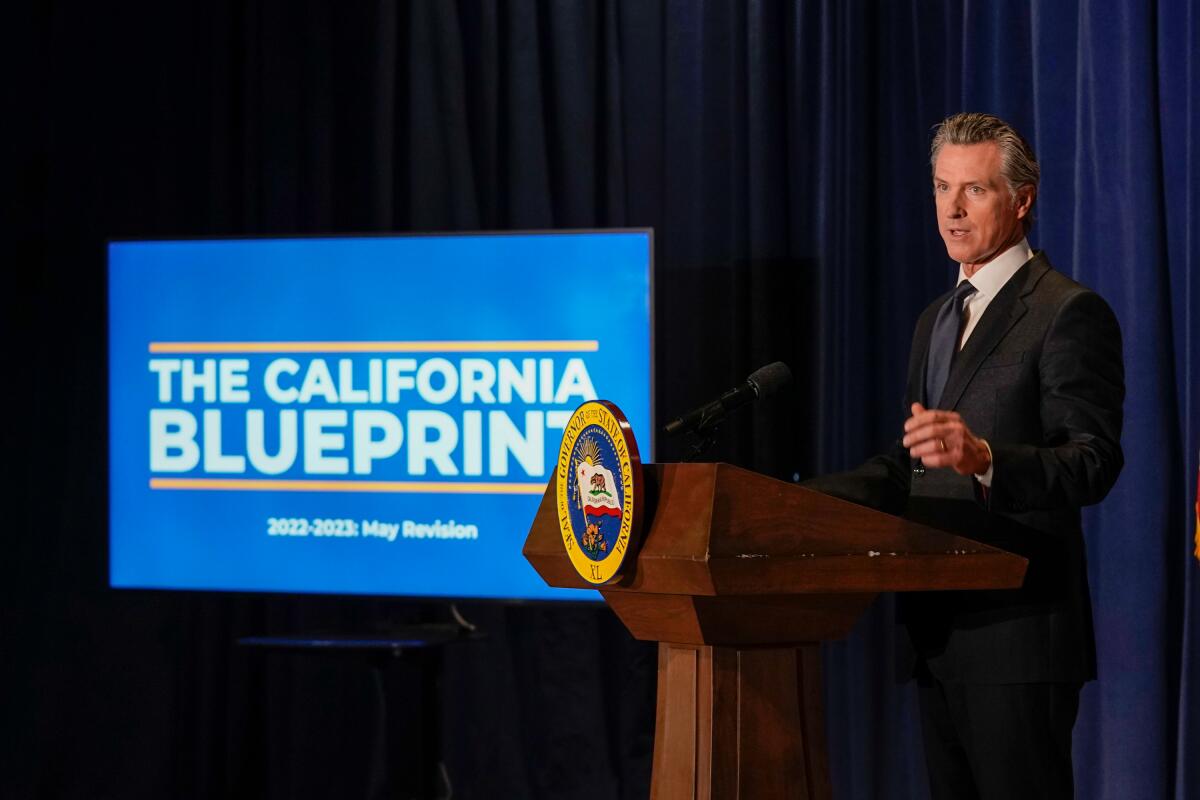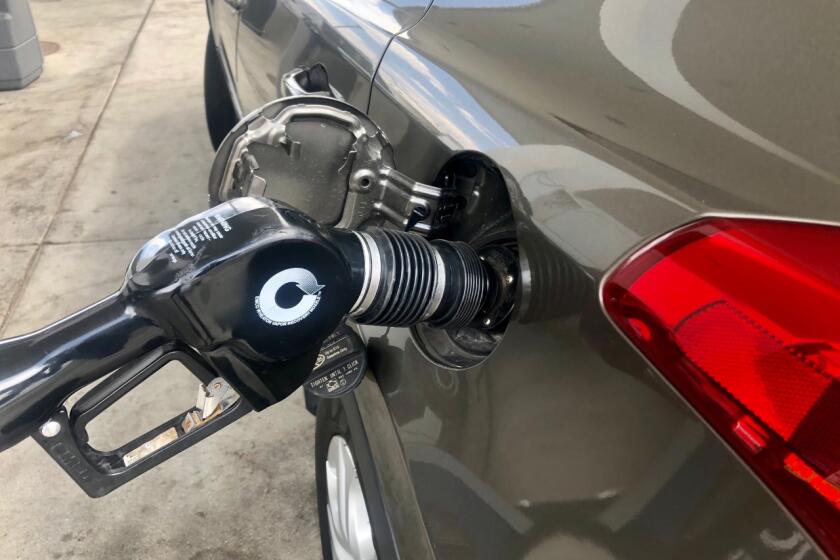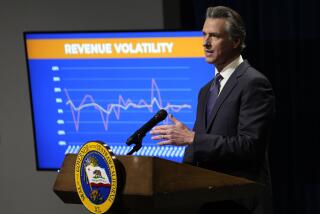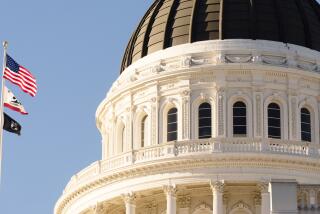California surplus expected to hit unprecedented $97 billion under Newsom’s budget plan

- Share via
SACRAMENTO — California’s government surplus is expected to balloon to $97.5-billion by next summer under the budget plan unveiled Friday by Gov. Gavin Newsom, an estimate that vastly exceeds previous projections and comes amid concerns that rising inflation and arcane spending rules could throw the state’s finances into disarray in the near future.
Many of the governor’s ideas on how to use the extra cash — including rebates, new debt repayments and additional funding for public schools — are contained in a $300.6-billion budget blueprint for the fiscal year that begins in July. Other portions of the surplus would be set aside in the state’s cash reserves.
“No other state in American history has ever experienced a surplus as large as this,” Newsom said at a news conference in Sacramento.
The revised budget Newsom will send to the Legislature reflects $14 billion in additional spending for the fiscal year that begins in July, most of it for K-12 education. It also ratchets up total spending for the current fiscal year, as the surplus is spread across both time frames. While other estimates have been floated in recent weeks, Friday’s proposal reflects the first full accounting of tax receipts collected in April.
The governor’s budget asks lawmakers to devote billions of dollars to a raft of new items: an inflation relief package for Californians, more money to address dangerous drought and wildfire conditions, subsidies for low- and middle-income healthcare plans and the highest per-pupil school funding levels in the state’s history.
Government spending of the magnitude envisioned by Newsom would be made possible, in large part, by the remarkable investment earnings of California’s wealthiest taxpayers.
“It’s a sign of what’s happening, in some respect across this nation and around the world, a concentration of wealth and success in the hands of a few that are enjoying abundance in historic and unprecedented ways,” Newsom said.
The new budget, a revision to the plan Newsom offered in January, points to the outsized role that taxes paid on capital gains have on the state’s finances. Those dollars now make up a higher percentage of personal income taxes collected than at any point since 1999 — which Newsom pointed out occurred just before the collapse of the state’s dot-com industry, an implosion that helped trigger massive state budget deficits for much of the decade that followed.
“For those that are concerned about that, they are right to be concerned about that. We are deeply mindful of that,” Newsom said in offering what he insisted is a cautious plan focused on short-term spending proposals.
Compared to Newsom’s January plan, the most notable change reflects new worries about the effect of rising inflation. The governor’s budget earmarks $18.1 billion in short-term relief, with more than 60% of the money to be distributed through $400 cash payments to Californians who own a vehicle.
Gov. Gavin Newsom and lawmakers have made little progress toward resolving their differences over how much money Californians should receive to blunt the burden of rising costs at the pump.
But that effort has found little support in the Legislature since it was announced by Newsom in March. Democratic legislative leaders have instead urged the adoption of a plan to distribute relief funds based on adjusted gross income, not whether someone owns a car. Resolving the disagreement over who gets the money is likely to be a key part of private negotiations between Newsom and the Legislature in the coming weeks.
“I have confidence we’ll land very, very quickly on an agreement,” Newsom said on Friday.
The governor’s inflation relief plan also includes money to provide help to struggling renters who applied for a state rental assistance program by March 31. Some low-income residents would also be eligible for help paying utility bills and for free public transit rides under Newsom’s budget plan.
Californians who work in hospitals and skilled nursing facilities could receive cash stipends of $1,500 per person under the budget’s inflation relief package — or, if the employer provides matching funds, up to $2,000 per worker.
Newsom’s budget overview did not explicitly lay out the chances of a sharp reversal of fortunes in the coming years — even though the financial warning signs have been visible for months. In the spring, the independent Legislative Analyst’s Office reported that a simulation of 10,000 possible state revenue scenarios resulted in shortfalls 95% of the time.
No problem looms larger, the analysts said, than the confusing outcome of how new tax revenue must be treated under a spending limit enshrined in the California Constitution — a 1979 voter-approved amendment that triggers mandatory education spending and tax rebates when cash receipts breach a predetermined cap.
Anti-tax activist Paul Gann’s 1979 ballot measure to limit state spending, a follow-up to Proposition 13, may be more relevant now than ever.
Newsom’s latest budget plan essentially erases the concerns his staff laid out in January about the constitutional spending limit.
Keely Martin Bosler, the governor’s finance director, said that three new, large spending proposals — the inflation relief package, additional spending on infrastructure and more funding for COVID-19 and drought response efforts — are excluded from calculations of the spending limit.
Legislators have pitched their own one-time workaround for this year. But there is growing agreement in the state Capitol that the 1979 law needs to be formally modified through a ballot measure sent to voters in 2024.
The governor embraced that idea Friday, but with a twist: He would also ask voters to allow the state to expand the size of the budget’s “rainy day fund,” potentially attaching a politically popular reform idea with one that could allow large growth in long-term government spending.
The new state budget blueprint also reflects changes in the political climate. Newsom is asking lawmakers to set aside $125 million for expanded access to abortion services, an effort that kicked into high gear almost two weeks ago after the unauthorized leak of a draft U.S. Supreme Court opinion to overturn the ruling in Roe vs. Wade. The revised budget calls for spending $40 million in taxpayer funds to subsidize abortion-related resources for low-income women, including those who may travel to California from other states.
Not all spending decisions envisioned by Newsom’s budget are fully fleshed out.
The revised plan includes scant details on how much it will cost to fully implement the governor’s sweeping proposal to provide court-ordered treatment for homeless individuals with severe mental illness and behavioral health needs. The so-called Community Assistance, Recovery and Empowerment Court would create a new civil justice treatment program for some 7,000 to 12,000 Californians experiencing psychiatric conditions such as schizophrenia, and who need treatment and shelter to stabilize.
For up to two years, a CARE plan would help connect participants to medication and a variety of mental health services, along with a housing plan, a public defender and a personal advocate.
Newsom proposed new funding for the state Department of Aging and $39.5 million for the judicial branch to conduct CARE Court hearings and provide other related services. But there is no clear sense of what the state might need to pay for the services that would be provided by county governments.
Some elements of Newsom’s budget are unlikely to change as lawmakers begin to consider their own priorities. Funding for public schools, largely controlled by formulas in the California Constitution, would grow to $128.3 billion, an amount that’s larger than the entire state budget in 2005.
When gathering both state and federal funds, California would spend $22,850 per student in the upcoming academic year, with substantial funding for the new commitment to transitional kindergarten and larger subsidies for low-income families to access child care.
Critics said the governor could have done more. Advocates for low-income families said Friday that the governor’s proposal does not do enough to assist the state’s most vulnerable. They are pushing for health benefits for child-care workers, food benefits for all eligible Californians regardless of immigration status, the elimination of some court fees, and even more funding for schools.
Republican lawmakers, whose votes are not needed to enact a budget in a Legislature dominated by Democrats, say the largesse in tax revenue merits a permanent cut in taxes and investments in large water storage projects.
Although lawmakers have passed on-time budgets for the past decade, the process in recent years has dragged on far beyond the June 15 constitutional deadline. The governor and Democratic leaders in those instances have quickly settled on a broad framework — meeting the official finishing date and ensuring legislative salaries aren’t forfeited.
But officials have then spent days or even weeks haggling over the fine print, ultimately laying out the details in supplemental budget bills approved by the Legislature through votes taken into early summer.
Times staff writers Hannah Wiley and Mackenzie Mays contributed to this report.
More to Read
Sign up for Essential California
The most important California stories and recommendations in your inbox every morning.
You may occasionally receive promotional content from the Los Angeles Times.













